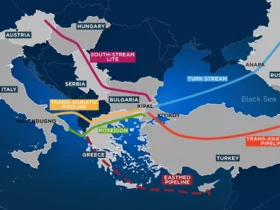ASEAN environmental sustainability depends on how digital technologies become localized.
ASEAN environmental sustainability depends on how digital technologies become localized.
By Mehmet Enes Beşer
The environmental sustainability experience of Southeast Asia is an uneven and rugged terrain, shaped by forces that intersect but refuse to move together in harmony. As the ASEAN countries speed up to discover the middle path between economic development and nature protection, they must contend with the unbalanced consequences of the leading drivers—digitalization, natural resource exploitation, capital buildup, and green innovation. These forces, important in themselves, do not impinge upon environmental consequences in the same way throughout the region. They are shaped by national steering institutions, institutional capabilities, socio-economic structures, and the different levels of technological preparedness and ecological sensitivity within the bloc. The vantage point in accounting for this unbalancing is digitalization.
Successfully marketed as an environmental force multiplier—through smart grids, precision agriculture, digital waste management, and real-time pollution monitoring—digital technologies can enhance transparency, efficiency, and citizen engagement. The environmental impacts of digitalization are very unevenly realized in ASEAN. In Singapore and Malaysia, for example, where digital infrastructure is well-developed and institutional capacity is strong, the environmental applications of digital technologies have yielded concrete returns. Smart grids in Singapore, for instance, have reduced per capita emissions at no cost to growth. Cambodia and Myanmar are less lucky, where the digital infrastructure remains underdeveloped and governance is fragmented.
Digitalization in such places is of partial coverage and uncertain impact, and will more likely than not increase existing disparities rather than reduce them. Last but not least, the digital economy is not automatically green. Increased use of data, more e-waste, and carbon output by ICT facilities and server farms can negate environmental gains unless well managed. Without regulation and proper planning, the green potential of digitalization can prove to be a development illusion. Endowments of natural resources provide yet another axis of asymmetry.
ASEAN countries are richly endowed with ample biodiversity, minerals, forests, and oceanic resources. Yet the administration of such resources is markedly different, and their subsequent environmental track also differs. Indonesia, for example, natural riches of coal, palm oil, and nickel in the past have created extractive policies at tremendous environmental expense—deforestation, water pollution, and carbon emissions. Despite the country’s haste towards green technology through electric car production or carbon trading, its heavy dependence on resource extraction makes it a paradox of sustainability. Contrast this with Laos, whose hydropower has been presented as a policy of clean energy export.
Tangentially in support of decarbonization, the environmental cost—gutted river flows, erosion of biodiversity, and people displacement—adds complexity to the tale of sustainability. The question is not so much one of resource abundance as it is of governance arrangements that dictate the way resources are created, for whom, and how ecological costs are kept down or transferred. Ecological sustainability in ASEAN thus depends less on countries’ natural resource endowments, but rather on whether they internalize ecological considerations in resource management. Capital formation, once a long-term source of support for development, also carries dubious environmental costs in the region. Gross capital formation statistics on one side can finance green infrastructure—clean transport systems, solar and windmills, and sewage treatment plants. Capital-intensive investments, on the other hand, trigger conventional infrastructure: mines, industrial parks, highways, and fossil fuel-based power plants. The environmental character of capital formation depends not on its size but on structure.
Vietnam is a growing example of this dualism.
It has nurtured both utility-scale solar and coal power initiatives in its capital development over the past decade. In the absence of the leadership of focused policy guidance and green investing standards, capital flows can end up institutionalizing unsustainable infrastructure rather than transforming it. Those nations like the Philippines and Thailand that have established green bond frameworks and environmental, social, and governance (ESG) principles are beginning to channel funds to greener fronts. But in the majority of ASEAN economies, markets are underdeveloped, and private sector consciousness about sustainability-linked investments is in an infancy stage. Finally, green innovation—the catalyst of long-term environmental transformation—is equally unevenly distributed across ASEAN. Although emissions-reduction, waste-management, and sustainable-agriculture techno-solutions are found throughout the region, their innovation and rollout are vastly unequal. Singapore again is at the forefront with its robust R&D ecosystem, climate-tech accelerators, and state-backed innovation hotspots. Thailand and Malaysia have built clean energy technology and sustainable city planning, but these are hugely reliant on imported foreign technology and expertise.
Concurrently, in the poorer ASEAN nations, green innovation is donor-initiated, project-based, and poorly integrated into country development plans. Poor intellectual property rights protection, industry-university relationships, and availability of venture capital have robust boundaries limiting indigenous green technology development. Even when there exists innovation, the institutional facilitation of adoption opportunities weakens its scalability and diffusion.
These asymmetries—innovative, financial, resource, and technological—cumulatively form the regional environmental sustainability challenge.
They make one-size-fits-all prescriptions and across-the-board policy advice impossible. The diversity of the ASEAN regional group is its strength, but it requires differentiated solutions. It can focus on circular economy logic and efficiency technology for countries with superior digital infrastructure but limited resources. Low-capacity institution countries with endowments of natural resources must prioritize environmental protection and reform of governance before they open up for more extraction. Economically developed nations have to invest in green regional funds and technology transfer schemes to help less developed neighbors. The answer is not to minimize these asymmetries, but to accept and design policy around them.
ASEAN environmental sustainability will not be served by hot air commitments or one-size-fits-all proposals. It will depend on how digital technologies become localized, natural resources are governed, capital is mobilized, and bottom-up innovation ecosystems are built. They are asymmetrical environments—but not impossible ones. Homogeneity is not the solution, but regional fraternity based on adaptive, context-sensitive responses to shared ecological woes. Only then can ASEAN move from piecemeal measures to collective environmental resilience.

















Leave a Reply